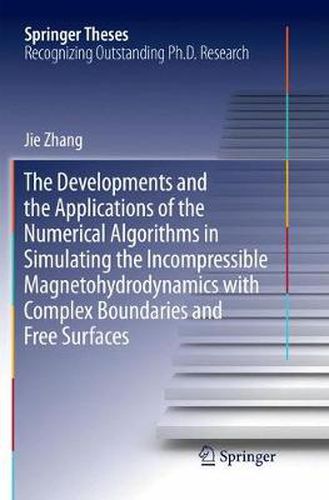Readings Newsletter
Become a Readings Member to make your shopping experience even easier.
Sign in or sign up for free!
You’re not far away from qualifying for FREE standard shipping within Australia
You’ve qualified for FREE standard shipping within Australia
The cart is loading…






This thesis presents an accurate and advanced numerical methodology to remedy difficulties such as direct numerical simulation of magnetohydrodynamic (MHD) flow in computational fluid dynamics (CFD), grid generation processes in tokamak fusion facilities, and the coupling between the surface tension force and Lorentz force in the metallurgical industry. In addition, on the basis of the numerical platform it establishes, it also investigates selected interesting topics, e.g. single bubble motion under the influence of either vertical or horizontal magnetic fields. Furthermore, it confirms the relation between the bubble’s path instability and wake instability, and observes the anisotropic (isotropic) effect of the vertical (horizontal) magnetic field on the vortex structures, which determines the dynamic behavior of the rising bubble.
The direct numerical simulation of magnetohydrodynamic (MHD) flows has proven difficult in the field of computational fluid dynamic (CFD) research, because it not only concerns the coupling of the equations governing the electromagnetic field and the fluid motion, but also calls for suitable numerical methods for computing the electromagnetic field. In tokamak fusion facilities, where the MHD effect is significant and the flow domain is complex, the process of grid generation requires considerable time and effort. Moreover, in the metallurgical industry, where multiphase MHD flows are usually encountered, the coupling between the surface tension force and Lorentz force adds to the difficulty of deriving direct numerical simulations.
$9.00 standard shipping within Australia
FREE standard shipping within Australia for orders over $100.00
Express & International shipping calculated at checkout
This thesis presents an accurate and advanced numerical methodology to remedy difficulties such as direct numerical simulation of magnetohydrodynamic (MHD) flow in computational fluid dynamics (CFD), grid generation processes in tokamak fusion facilities, and the coupling between the surface tension force and Lorentz force in the metallurgical industry. In addition, on the basis of the numerical platform it establishes, it also investigates selected interesting topics, e.g. single bubble motion under the influence of either vertical or horizontal magnetic fields. Furthermore, it confirms the relation between the bubble’s path instability and wake instability, and observes the anisotropic (isotropic) effect of the vertical (horizontal) magnetic field on the vortex structures, which determines the dynamic behavior of the rising bubble.
The direct numerical simulation of magnetohydrodynamic (MHD) flows has proven difficult in the field of computational fluid dynamic (CFD) research, because it not only concerns the coupling of the equations governing the electromagnetic field and the fluid motion, but also calls for suitable numerical methods for computing the electromagnetic field. In tokamak fusion facilities, where the MHD effect is significant and the flow domain is complex, the process of grid generation requires considerable time and effort. Moreover, in the metallurgical industry, where multiphase MHD flows are usually encountered, the coupling between the surface tension force and Lorentz force adds to the difficulty of deriving direct numerical simulations.